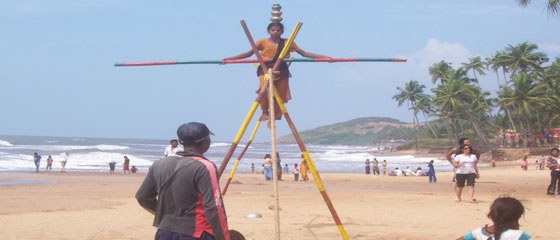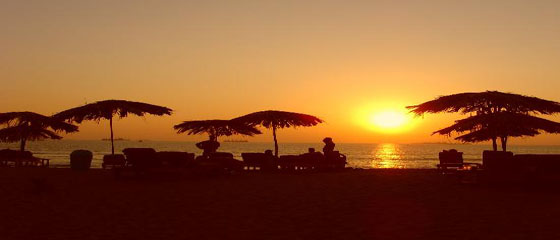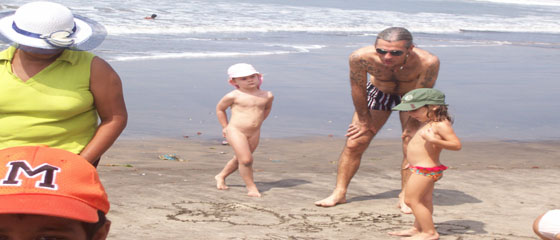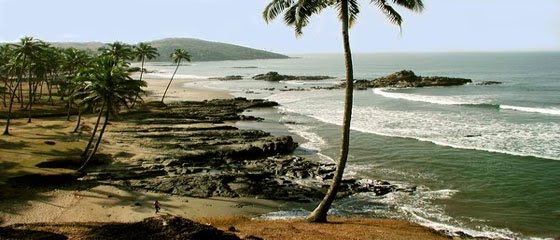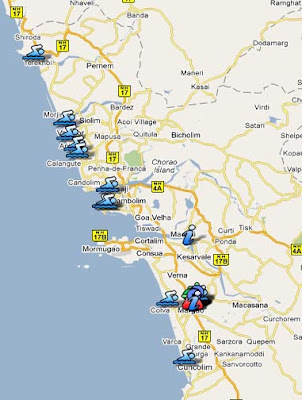
Goa - One of the most popular beach destinations worldwide that's perfectly suited for pure leisure, and for those seeking adventure. Goa is known for its heritage, picturesque villages dotted with white washed churches, beautiful temples, crumbling forts, palm-fringed beaches, coconut groves, bubbly folk music, availability of Alcohol at prices even cheaper than water, excellent nightlife, choicest cuisine, and more…
Click the respective links for details
History of Goa:
History of Goa is rather old. Its reference is found in the Ramayana and in the Mahabharata. Its old name accordingly were Govapuri. Later it became Gomantaka(fertile land). In the 3rd century BCE, Gomantaka (Goa) formed part of the Maurya Empire. From 2nd century BCE to the early age of AD it was ruled by the Satavahana dynasty. Eventually, it became a part of the Chalukya kings of Badami, who controlled it from 580 to 750. Over the next few centuries settlements grew in Goa under successively by the Silharas, the Kadambas and the Chalukyas of Kalyani. The Kadambas ruled Goa for centuries and gave it a distinct and cultural and architectural identity. In 1350 CE, Goa was occupied by the Bahmani Sultanate after the era of Kadamba kings. However, in 1370, king Harihar I of Vijayanagar empire, a resurgent Hindu empire situated at modern day Hampi, reconquered the area from Muslims. In 1469, Goa was reconquered, by the Bahmani Sultans of Gulbarga. When this dynasty broke up in 1492, Goa reverted to the Adil Shah's Bijapur Sultanate.
Since then Goa became the focal point for the foreigners. The Portuguese set sail and discovered Goa in 1510 and that lasted for 451 years was a benchmark in its history. Alfonso de Albuquerque captured Goa after defeating the Sultan of Bijapur in 25th Nov 1510. Goa was granted the same civic privileges as Lisbon. Since then, Goa became the free trade zone between east and west. Missionaries also came with the traders. The Portuguese demolished temples, built churches and converted people to Christianity. In 1757, King Joseph I of Portugal issued a decree penned by his prime minister, the Marquês de Pombal, granting the Portuguese citizenship and representation to all subjects in the Portuguese Indies. In 1787, there was a rebellion started by some priests against Portuguese rule. It became famous as the Conspiracy of the Pintos which inspired by French Revolution was an important development in Goan history. It was the first ethnic rebellion against Portuguese rule in Goa. Portuguese were encouraged to marry the local Goan women and to settle down in Goa. Offspring of these unions, the Mestizo or mixed were considered favorably by the Portuguese rulers, but the Mestizos were looked down upon by the locals.
In the mean time, the British engaged in a struggle against Tipu Sultan, marched towards Goa in 1797 but they left a year later. The 20th century began with a welcome development for Goa. The period of Republic(1910-1926) in Portugal brought a mini-renaissance in Goa.
The Portuguese chapter in the historical saga of Goa was about to come to an end after India gained Independence from the British in 1947. At first, Portugal refused to agree to India's demand to hand over the control of its enclave. Finally, on 17th December 1961, the Indian army marched into Goa forcibly and took political control by force. Fighting lasted for twenty-six hours before the Portuguese garrison surrendered. Goa, along with Daman and Diu was made into a centrally administered Union Territory on India. This operation is known as "Operation Vijay” which brought freedom to Goa on December 19, 1961. December 19th is now celebrated as the Goa Liberation Day. The UN Security Council considered a resolution condemning the invasion which was vetoed by the Soviet Union. Most nations later recognized India's action, and Portugal recognized it after the Carnation Revolution in 1974. On 30th May 1987, Goa spilt from Daman and Diu and was officially recognized as the 25th state of Indian Union.
The State of Goa has a Legislative Assembly with strength of 40 elected members. Besides, Goa has three elected representatives in the Parliament. The Governor is the Head of the State and is advised by a Council of Ministers headed by Chief Minister. Panaji, a small picturesque town on the left bank of river Mondovi, is the seat of the State Administration. However, for administrative purposes, the State has been divided into two districts: North Goa and South Goa with headquarters at Panaji and Margao respectively, and six divisions comprising 11 Talukas.
Goa spread in an area of 3,702 square kms lies between the latitudes 14°53'54" N and 15°40'00" N and longitudes 73°40'33" E and 74°20'13" E. Goa, with a coastline of 105 km, is a part of India’s western coast and western Ghats known as the Konkan. Except some places, the average height of Goa is 1020 meter above the mean-sea level. About one-quarter of the state is covered by forest. Goa has maritime equable climate, it is moderate and remains humid and sunny for most of the part of the year, with average January temperatures ranging from 19° to 29° C (66° to 84° F), and average June temperatures ranging from 25° to 33° C (77° to 91° F). Goa experiences a monsoon season from June through September; accounts for four-fifths of the state's average annual rainfall. 350 cms approximately from June to September. Humidity levels touch almost 95 percent during monsoon and fall to about 55 percent in the winter.
Best season to visit Goa is mainly between 15th September to April end, but from November to February is the peak tourist season- the atmosphere, at this time, is mild and pleasant.
Summer in Goa is a good time for a budget holiday- Summers mean fewer crowds and more discounts. The average daily hours of sunshine is nine to ten hours in summer. In summer during daytime heat will perhaps keep the visitors off the beaches and In the evenings one can take a stroll down the beaches and the soft breeze blowing through the leaves of the palm trees.
Goa in monsoons is largely empty of tourists, a good thing as you can enjoy a comfortable state of mind. It’s especially beautiful during monsoon time from June to August, when you discover a unique Goa with overflowing rivers and estuaries which criss-cross Goa, are swollen with rainwater, flowing with renewed gusto giving up their usual shades of blue-green to turn a deep orange-yellow, hills and vast expanses of fields coverd with green carpet, the rain brings refreshment and romance, and Goa takes on a more traditional flavor. Swimming in the sea at this time of the year is out of the question as the sea is very turbulent and the waves treacherous. It is the best time to explore ecotourism , spice plantations and walking barefoot along the beach and listen to the roar of the ocean.
Two types of tourists visit Goa; the first is the domestic tourists, who comprise 80 percent of all tourists. The second is the international tourists who visit Goa purely for the natural environment of tropical climate. Within the category ofinternational tourists there are two sub-categories: backpackers and charter tourists.
The backpackers are not found in areas of charter tourists; they prefer to mingle and live with the local communities. Whereas, the charter touriststend to stay in the luxury starred hotels.
The domestic and international both categories of tourists visit Goa for the beaches, they stay away from each other. Domestic and international tourists also differ in terms of the areas. For the domestic tourist, the beaches hold limited appeal, so domestic tourists remain away from the places frequented by the international tourists. The timings of visits are clearly different for the domestic and the international tourists. The domestic tourists come throughout the year albeit in larger numbers in the non-monsoon months whereas international tourists avoid the monsoon months; as for them the use of the beach is the prime attraction to come to Goa.
In 2002, a total number of 2,71,645 foreign tourists visited Goa. In 2004, a total number of 3,63,230 foreign tourists visited Goa. The foreign tourist visit during 2004 was higher by 14.4 % than the previous year. During April 2005-March 2006 a total number of 3,48, 396 foreign tourists visited Goa.
Goa's tourism business has suffered due to the economic slowdown in the last two years. While in 2007, 82,515 foreign visitors came to Goa by chartered and scheduled flights
between September and December, in 2008, the number dropped to 71,918 in the
corresponding period - a 13 per cent drop. Though the tourist season began in 2009 with a promise with 4,120 foreign tourists coming to the state in the month of October as against 2,837 in the previous year, the number of tourists arriving in November,2009 declined considerably with only 22,180 foreign tourists coming to Goa as against 25,788 during the same month last year, recording a fall of 3.608 tourists.
In 2004, a total number of 20,85,729 domestics tourists visited Goa. The domestics tourists visit during 2005 was 19,65,343. During 2006 a total number of 20,98, 654 domestics tourists visited Goa.
- Name of the State : Goa
- Capital: Panaji
- Districts: South Goa and North Goa
- Talukas: 11
- Languages: Konkani (official), English, Marathi and Hindi
- Religion: Hinduism( 65%), Christianity(30%) and Islam
- Area: 3,702 sq.kms.
- Population: 13,43,998 (2001 Census)
- Literates: 9,89,362 (2001 Census)
- Climate: Tropical
- Altitude: Sea level to 1,022 metres
- Summer: Mean Max. 33 C and Mean Min. 24 C
- Winter: Mean Max. 32.2 C and Mean Min 21 C
- Rainfall: 3,200 mms. from June to September
- Tourist Season: Throghtout the year
- Peak Season: November to February
- Time Zone: GMT/UTC +5.5
- Currency: Indian Rupees (Rs)
- Airport : Dabolim
- Railhead: Vasco-da-Gama and Margao
- Main Rivers: Mandovi, Zuari, Chapora, Tiracol, Sal
- Country Code: 0091
- STD Code: Panaji( 0832), Margao (08342), Ponda ( 08343), Mapusa (0832), Vasco ( 083451), Varca(08344)


